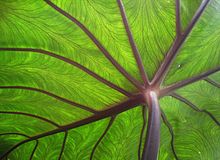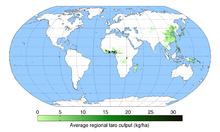Taro
![]()
The title of this article is ambiguous. For other meanings, see Taro (disambiguation).
The taro (Colocasia esculenta) is a species of plant in the arum family (Araceae). It is important as a useful plant for humans. The starchy rhizomes are eaten boiled or roasted.
Other names for taro are water bread root, colocasia, taioba, eddo, eddoe, eddro and dasheen. In old reference works, such as Pierer's Universal-Lexikon, the spelling Tarro can also be found.
In his work The Naturalist in Nicaragua (1874, Chapter V), Thomas Belt gives the name Quequisque, which is common in Nicaragua. In the meantime, the name Malanga has become accepted there, but this actually refers to the similar Tannia. In eastern Ecuador, too, these two distinct genera are popularly called Papa china. In India, taro is known as albi and in Japan as sato-imo (里芋). It is also called elephant ear plant. In the Philippines, it is called gabi.
Other species are also called taro or elephant ear plant - the giant-leaved arrowleaf (Alocasia macrorrhizos), tannia (Xanthosoma sagittifolium), Cyrtosperma merkusii and other species of the genus Colocasia.
Description
Taro is an evergreen, perennial, herbaceous plant that reaches growth heights of between 1 and 2 metres. The plants form ellipsoidal to club-shaped rhizomes that grow both vertically and horizontally in the soil. The potato-like rhizomes are fleshy and average 3 to 5 centimeters in diameter. In cultivated forms, the rhizomes reach diameters of up to 15 centimeters. They have a brown, rough skin with scattered, thin root threads and ring-shaped scars surrounding the whitish, often mottled brownish to purple, starchy "flesh". They can weigh 3.5 to 4 kilograms.
In addition to the rhizomes, taro forms long, horizontally spreading stolons. The stolons form thickened nodes.
The chromosome number is 2n = 26, 28, 30, 36, 38, 42, 44, 46, 48, 52, 58, 84 or 116. The large number of deviating chromosome numbers is due to the fact that Taro chromosomes are very unstable during cell division and behave unpredictably. The most common chromosome numbers are 2n = 28 or 42.
Leaves
Each plant forms 2, 3 or more, simple, arrow- to heart-shaped, eccentrically petiolate (i.e. the petiole attaches to the underside of the blade) leaves with rounded lobes. The sinus usually does not extend down to the base of the petiole. However, "normal" leaves are also formed which have the petiole base at the base of the blade. The leaves can be drooping, horizontal, as well as erect with the tip upwards or downwards on the stem. Sometimes the leaf base is also folded or shell-shaped on the upper side. The soft, leathery, smooth, velvety leaf blades are glabrous and green, dark green, sometimes whitish or bluish-purple variegated, paler on the underside. There are also variations with blue-purple or with slightly bluish, also with black-blue and orange-bluish leaves. The spreading surface is waxy and superhydrophobic water repellent. The tip is acute to obtuse or acuminate, occasionally acuminate.
The leaf margins are entire to cove-shaped and often slightly wavy or also partly bent. The blades usually measure between 10 and 45 centimetres in length and 10 to 35 centimetres in width, but can also grow significantly larger to 80 by 60 centimetres. They are also called "elephant ears" because of their size.
The nerves are whitish to purplish also brownish, but there are also variations with purplish nerves and margins. There are three primary principal nerves, one centrally towards the tip and two towards the basal lobes. The secondary lateral veins run obliquely from the basal point, parallel forward and backward, and the tertiary ones are spread like a net.
The normally green, upwardly tapering, erect to outwardly curved, smooth petioles are arranged basally riding and between 20 and 80 centimeters long, in extreme cases up to 180 centimeters. The lower part, one-third to one-half, is guttered on the upper side, the gutter edges partly inrolled. The interior of the petioles is spongy (succulent) with air bubbles. There are also variations with partly orange as well as reddish or dark purple petioles.
Blossoms
As is usual with the arum family, the inflorescence consists of an inflorescence stem, a bracts (spatha) and the spadix.
Mostly a single inflorescence is formed on a 15 to 50 centimetre high stem. The lanceolate spatha grows between 10 and 40 centimetres long and up to 6 centimetres wide. On the lower 4 to 5.5 centimeters, it forms a green tube up to 2 centimeters in diameter, which then opens after the fruit ripens. The spatha is cream to golden yellow and hooded, boat-shaped (cymbiform), with a curled tip. It usually surrounds the somewhat protruding spadix on the back. However, it can be shaped differently, bent back, rolled back, hanging backwards, twisted, as well as rolled back and bent forward or also flat protruding backwards.
The protruding spadix is more than three times as long as the tube and measures between 12 and 16.5 centimeters. The spadix divides into a female and male section, these are separated by a sterile.
The female section at the base, wrapped by the tube, is conically thickened and measures up to 3.5 centimeters. The female fertile flowers are green, with a white pistil. The upper ovary is unilocular (with one ovary compartment) with 36 to 67 ovules and measures from 1 to 3 millimeters in diameter. The lower section is also interspersed with infertile female flowers. The sterile flowers are cream to yellowish and measure about 0.5 millimeters in diameter. The subsequent, constricted, sterile section, with sterile female flowers, is cylindrical and up to about 3 centimeters long.
The male section in the upper part of the spadix is conical and the longest section, 4 to 6.5 centimeters long. The male flowers are pale orange with three to six fused stamens. The anthers are fused into a synandrium.
The unisexual flowers are naked-flowered (achlamydean).
The white-yellowish to about 4 centimetres long tip (appendix) of the spadix bears no flowers and is conically tapered. It is usually shorter than the male section, but may be longer or absent altogether.
Fruits
The fruits are green or reddish-orange, ellipsoid berries about 3 to 5 millimeters in diameter. The ovoid, longitudinally ribbed, light yellowish-brown seeds are between 1 and 1.5 millimeters long and about 0.8 millimeters wide; there may be up to 50 per berry. The thousand-seed mass is only 0.2 grams.

Detailed view of a taro leaf with recognizable leaf veining

Flower of Colocasia esculenta

Taro rhizomes (tubers)
Locations and distribution
Due to the large foliage leaves, from which a lot of moisture evaporates, taro needs a lot of water. Optimal is an annual precipitation between 1500 and 2000 millimeters. The substrate should also be very moist. An average temperature of 21 °C is optimal. The species is not frost resistant. Normally taro grows at altitudes up to 1000 metres; the maximum altitude to which taro still thrives is 2700 metres in New Guinea. The species loves full sun locations and rich soils with a pH between 5.5 and 6.5 (slightly acidic).
The largest taro populations are found in plantations in fields or water fields. Wild taro often forms large colonies in wet locations along rivers, canals or ponds. However, colonies are also found in damp places in forests or marshes.
Today, taro has a pantropical distribution, but in most locations it was introduced by humans. Research suggests that the original wild taro originated from the Malay Peninsula, but there were also natural occurrences in India, where the species was already cultivated around 5000 BC. From there, the species spread through humans first throughout Southeast Asia, into China and onto Japan. Other researchers claim that there were also original taro occurrences on New Guinea. Taro already reached the Pacific during the first settlement of the islands up to 3500 years ago.
Cultivated taro from Japan and China reached Egypt around 100 BC, was cultivated there and spread across the Mediterranean. Around the year 1, the species spread along the east coast of Africa. From there, taro reached West Africa and probably the Caribbean on slave ships. In Florida, taro is considered an invasive weed.

Map of worldwide taro production
Search within the encyclopedia